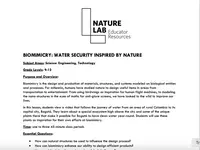Biomimicry: Water Security Inspired by Nature
https://www.nature.org/content/dam/tnc/nature/en/documents/nature-lab-lesson-plans/NLBiomimicry.pdf
https://www.nature.org/content/dam/tnc/nature/en/documents/nature-lab-lesson-plans/NLBiomimicry.pdf
The Nature Conservancy
This resource uses a short video, powerpoints, and a tangible classroom activity to help students understand concepts of biomimicry as it relates to water catchment infrastructure and nature inspired solutions.
Video length is 9:00 min
Learn more about Teaching Climate Literacy and Energy Awareness»Grade Level
Regional Focus
Online Readiness
Topics
Climate Literacy
This Activity builds on the following concepts of Climate Literacy.
Click a topic below for supporting information, teaching ideas, and sample activities.
Notes From Our Reviewers
The CLEAN collection is hand-picked and rigorously reviewed for scientific accuracy and classroom effectiveness.
Read what our review team had to say about this resource below or learn more about
how CLEAN reviews teaching materials
Teaching Tips | Science | Pedagogy |
Technical Details
Teaching Tips
- Consider extending the activity by having students think up other biomimicry inspired solutions.
- This activity may be a better fit for middle school rather than high school, and it is suggested that the user build in additional steps for high school students. This can be done in the introduction to the activity or within the design challenge. To raise the rigor of the lesson, consider building a context that will require deeper engagement in the process of designing a solution.
- This activity would be best after students have an understanding of water resources (where it comes from, where it goes, how it is cleaned, issues surrounding water quantity and quality).
- This activity would be fun and relevant in the context of a unit/chapter on water resources. This is a good framework of an activity, and it is suggested that the user read the entire activity, and modify it for their teaching scenario.
About the Content
- Students are introduced to the term biomimicry, and apply this term to a short activity where they design, create, and test their own water catchment system inspired by the frailejón plant that is described in a video. Students will also think critically about the specific qualities of certain plants to understand how engineers design purposeful infrastructure.
- This activity focuses on water security solutions through the use of biomimicry. Students learn about a plant in a region of Columbia that captures water, and then are posed with a challenge to design a solution modeled after that plant to capture and store water. Students employ the engineering design process in developing their solution. Although a few references are not available, the ones that were included were helpful.
- Passed initial science review – expert science review pending.
About the Pedagogy
- This activity uses a variety of media to teach major concepts in biomimicry and engineering that will engage a diversity of learning styles. There are no modifications for diverse student populations requiring various instructional supports.
- A complete teacher guide is included with guiding discussion questions, a rubric, powerpoint materials, and a step-by-step guide for the activity.
- Most of the objectives were written for the classes doing "Option One" in Explore. If "Option Two" is selected, students are researching a topic only. The Evaluate section appears to reflect those participating in "Option One."
Technical Details/Ease of Use
- If Option One is selected, an array of materials need to be gathered for students to use their creativity in the engineering design challenge.
- Several hyperlinks in the lesson were broken at the time of review (the Water - Source of Life video and the Biomimicry powerpoint). These two resources can be found at https://www.nature.org/en-us/about-us/who-we-are/how-we-work/youth-engagement/nature-lab/high-school-lesson-plans/
- In addition, the Biomimicry Evaluation Guidelines handout is not available.








